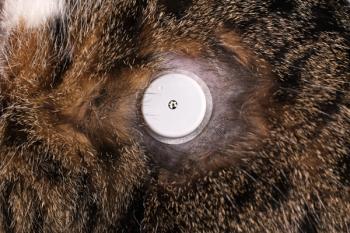
Research Updates: Dogs with gallbladder mucoceles may be prone to common endocrine diseases
This study establishes that there is a high prevalence of hyperadrenocorticism in dogs with gallbladder mucoceles and suggests that a similar association may be present between hypothyroidism and mucocele development.
Previous reports of dogs with gallbladder mucoceles have suggested an association with hypothyroidism and hyperadrenocorticism.1,2 This study's goal was to determine the frequency of diagnosis of three common endocrinopathies in dogs with gallbladder mucoceles and, thus, the relative increase in risk of gallbladder mucocele development in dogs with hypothyroidism, hyperadrenocorticism, or diabetes mellitus.
Erika Meler, DVM, MS
Seventy-eight dogs with gallbladder mucoceles were retrospectively age- and breed-matched to 156 control dogs with normal gallbladders as determined by abdominal ultrasonography examination or exploratory laparotomy (two normal dogs for each dog with a gallbladder mucocele). Records were reviewed to determine whether the dogs had also had a diagnosis of an endocrinopathy before or up to six months after the identification of a gallbladder mucocele.
Barrak Pressler, DVM, PhD, DACVIM
The percentage of dogs with hypothyroidism, hyperadrenocorticism, or diabetes mellitus in the gallbladder mucocele group were 14%, 21%, and 3%, respectively, vs. 5%, 2%, and 2%, respectively, in the control group. Dogs with hypothyroidism were three times more likely to have a gallbladder mucocele than euthyroid dogs were, and dogs with hyperadrenocorticism were 29 times more likely to have gallbladder mucoceles than were dogs without hyperadrenocorticism. Diabetes mellitus did not increase the likelihood of diagnosis of a gallbladder mucocele. However, because the number of dogs tested for hypothyroidism was significantly greater in the gallbladder mucocele group than in the control group, the difference in disease prevalence of this endocrinopathy may be due to a decreased likelihood of detection in dogs with normal gallbladders rather than a true association between these diseases.
COMMENTARY
This study establishes that there is a high prevalence of hyperadrenocorticism in dogs with gallbladder mucoceles and suggests that a similar association may be present between hypothyroidism and mucocele development. It should be pointed out that in both groups only those dogs with clinical signs compatible with endocrinopathies were tested for hypothyroidism or hyperadrenocorticism. Therefore, although significantly different from each other, the precise odds ratios determined by the authors may have differed if all dogs in either population had been tested, rather than the testing being performed at the clinician's discretion.
Nevertheless, based on these results, it appears reasonable to recommend that dogs with gallbladder mucoceles undergo additional testing for hyperadrenocorticism and hypothyroidism, particularly those dogs with physical examination results or clinicopathologic findings suggestive of either of these endocrinopathies. Thyroid hormone deficiency and hypercortisolemia are known to result in gallbladder hypocontractility, alteration in bile composition (particularly through increased mucin secretion), and increased contraction or tonicity of the sphincter of Oddi, all of which could result in prolonged bile retention and predispose the patient to mucocele formation. Hyperlipidemia may also play a role in gallbladder mucocele development because, in addition to the hypertriglyceridemia and hypercholesterolemia associated with hypothyroidism and hyperadrenocorticism, mucoceles are commonly reported in breeds with heritable dyslipidemias (Shetland sheepdogs) or dogs that have received glucocorticoids. In short, even in the absence of obvious physical examination findings consistent with either hypothyroidism or hyperadrenocorticism, tentative evidence suggests that more systematic testing for one or both of these endocrinopathies may be merited in affected dogs.1
Conversely, you should perhaps consider the development of a gallbladder mucocele as a more likely differential diagnosis in dogs previously identified as having hyperadrenocorticism or hypothyroidism that newly present with clinicopathologic findings consistent with hepatobiliary disease. However, it is unknown if earlier diagnosis and treatment of these endocrinopathies in affected dogs would have slowed, reversed, or prevented the formation of gallbladder mucoceles.
Finally, in this study, the authors did not find that Shetland sheepdogs were predisposed to gallbladder mucocele formation. That finding is in contrast to other publications and general anecdotal impressions in the United States and suggests caution, as these results may not hold true in dog populations in other geographic areas.
Mesich ML, Mayhew PD, Paek M, et al. Gall bladder mucoceles and their association with endocrinopathies in dogs: a retrospective case-control study. J Small Anim Pract 2009;50(12):630-635.
The information in "Research Updates" was provided by Erika Meler, DVM, MS, and Barrak Pressler, DVM, PhD, DACVIM, Department of Veterinary Clinical Sciences, School of Veterinary Medicine, Purdue University, West Lafayette, IN 47907.
REFERENCES
1. Aguirre AL, Center SA, Randolph JF, et al. Gallbladder disease in Shetland sheepdogs: 38 cases (1995-2005). J Am Vet Med Assoc 2007;231(1):79-88.
2. Walter R, Dunn M, D'Anjou MA, et al. Nonsurgical resolution of gallbladder mucocele in two dogs. J Am Vet Med Assoc 2008;232(11):1688-1693.
Newsletter
From exam room tips to practice management insights, get trusted veterinary news delivered straight to your inbox—subscribe to dvm360.






